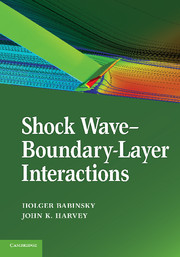Book contents
- Frontmatter
- Brief Contents
- Contents
- Contributors
- 1 Introduction
- 2 Physical Introduction
- 3 Transonic Shock Wave???Boundary-Layer Interactions
- 4 Ideal-Gas Shock Wave???Turbulent Boundary-Layer Interactions (STBLIs) in Supersonic Flows and Their Modeling: Two-Dimensional Interactions
- 5 Ideal-Gas Shock Wave???Turbulent Boundary-Layer Interactions in Supersonic Flows and Their Modeling: Three-Dimensional Interactions
- 6 Experimental Studies of Shock Wave???Boundary-Layer Interactions in Hypersonic Flows
- 7 Numerical Simulation of Hypersonic Shock Wave???Boundary-Layer Interactions
- 8 Shock Wave???Boundary-Layer Interactions Occurring in Hypersonic Flows in the Upper Atmosphere
- 9 Shock-Wave Unsteadiness in Turbulent Shock Boundary-Layer Interactions
- 10 Analytical Treatment of Shock Wave???Boundary-Layer Interactions
- Index
- References
6 - Experimental Studies of Shock Wave???Boundary-Layer Interactions in Hypersonic Flows
Published online by Cambridge University Press: 05 June 2012
- Frontmatter
- Brief Contents
- Contents
- Contributors
- 1 Introduction
- 2 Physical Introduction
- 3 Transonic Shock Wave???Boundary-Layer Interactions
- 4 Ideal-Gas Shock Wave???Turbulent Boundary-Layer Interactions (STBLIs) in Supersonic Flows and Their Modeling: Two-Dimensional Interactions
- 5 Ideal-Gas Shock Wave???Turbulent Boundary-Layer Interactions in Supersonic Flows and Their Modeling: Three-Dimensional Interactions
- 6 Experimental Studies of Shock Wave???Boundary-Layer Interactions in Hypersonic Flows
- 7 Numerical Simulation of Hypersonic Shock Wave???Boundary-Layer Interactions
- 8 Shock Wave???Boundary-Layer Interactions Occurring in Hypersonic Flows in the Upper Atmosphere
- 9 Shock-Wave Unsteadiness in Turbulent Shock Boundary-Layer Interactions
- 10 Analytical Treatment of Shock Wave???Boundary-Layer Interactions
- Index
- References
Summary
Introduction
Some of the most serious and challenging problems encountered by the designers of hypersonic vehicles arise because of the severity of the heating loads and the steepness of the flow gradients that are generated in shock wave–boundary layer interaction (SBLI) regions. The characteristics of these flows are difficult to predict accurately due in no small measure to the significant complexity caused by shear-layer transition, which occurs at very low Reynolds numbers and can lead to enhanced heating loads and large-scale unsteadiness. Even for completely laminar flows, viscous interaction can degrade appreciably the performance of control and propulsion systems. It is interesting that both of the two major problems encountered with the U.S. Space Shuttle program were associated with SBLI. The first was the so-called Shuttle Flap Anomaly that nearly resulted in disaster on the craft's maiden flight due to a failure in the design phases to account correctly for the influence of real-gas effects on the shock-interaction regions over the control surfaces. During the flight, a significantly larger flap deflection was required to stabilize the vehicle than had been determined from ground tests in cold-flow facilities. Miraculously, it was possible to achieve the necessary control, and disaster was narrowly averted. The second problem was the leading-edge structural failure caused by the impact of foam that had been fractured and released from the shuttle tank as a result of the dynamic loads caused by a shock interaction. Figure 6.1 is an example of the shock structures that are generated among the shuttle, the main tank, and the solid reusable boosters. The contour plot illustrates the corresponding computer-predicted pressure distribution. Aerothermal loads generated by shock waves in the region of the bipod that supports the shuttle nose caused the foam glove to be fractured and released. Unfortunately, the damage this caused resulted in a tragic accident.
Information
- Type
- Chapter
- Information
- Shock Wave-Boundary-Layer Interactions , pp. 259 - 313Publisher: Cambridge University PressPrint publication year: 2011
References
Accessibility standard: Unknown
Why this information is here
This section outlines the accessibility features of this content - including support for screen readers, full keyboard navigation and high-contrast display options. This may not be relevant for you.Accessibility Information
- 6
- Cited by
